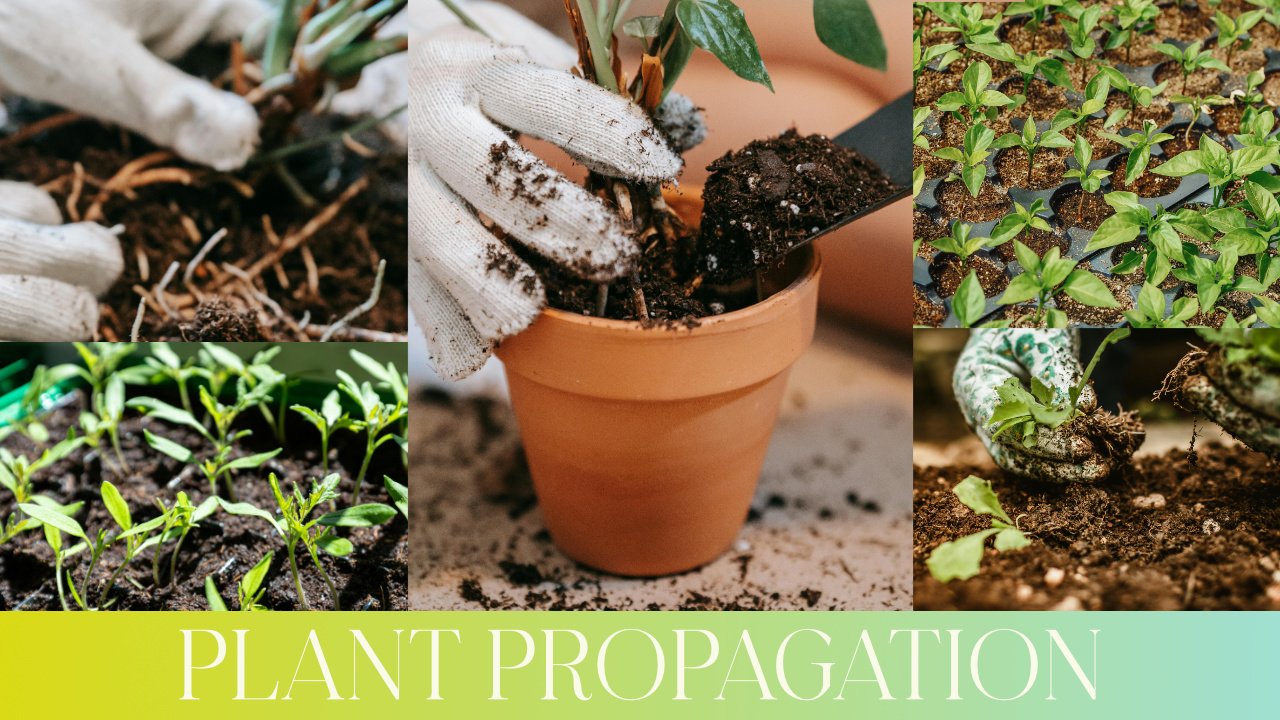You can use several methods to propagate plants. However, not all plants can be propagated in the same way. When you choose the propagation method for a particular plant, you should also consider your gardening skills and the goals you are trying to achieve. For example, if you want just an apple tree, you can propagate it from seeds, but if you want an apple tree that is identical to the tree that you have, you need to choose a method of propagation that will ensure the identical plant (like grafting, or air layering). Here are some of the most common methods you can use to propagate plants:
- Propagate Plants from Seeds
- Propagate Plants from Cuttings
- Propagate Plants by Division
- Propagate Plants by Layering
- Propagate Plants by Grafting
- Propagate Plants by Runners
- Propagate Plants by Bulb Offsets
- Propagate Plants using Suckers
Propagate Plants from Seeds:
If your plant is not a sterile hybrid and sets seeds or bears fruits with seeds, you can try seed propagation. However, keep in mind that plants grown from seeds, in many cases, will not be identical to parent plants in all their characteristics. For example, an apple seed will always grow an apple tree, but it may have completely different fruits or flowers than its parent. An heirloom tomato grown from seeds will most likely produce identical fruits because tomatoes are self-pollinating unless an insect has pollinated them (this is rare, but to prevent pollination completely, you can use fine mesh bags ). At the same time, seeds harvested from hybrid tomatoes will most likely grow different fruits because they have parent plants with different characteristics (that’s why they are called “hybrids”).
How to propagate plants from seeds: You can buy seeds or collect ripe seeds (learn more about seed saving) from the plant you want to propagate. Check if the seeds of this plant require stratification (treatment with cold) or scarification (scratching of the surface). As a rule, only seeds from plants growing in cold climates may require stratification. All vegetables (except for some perennial vegetables) do not require stratification. However, most deciduous trees need cold treatment for the seeds to germinate.
It is important to follow specific germination requirements for each plant because some seeds may require particular temperatures or conditions to germinate. If you can’t find instructions, most seeds will successfully germinate at around 18-20C (64-68F). Make sure to use fresh and viable seeds.
You can sow seeds in the seed-starting mix or directly in the garden soil if conditions are suitable for the plant you are trying to grow. For example, if you are trying to grow warm-loving plants like tomatoes, peppers or cucumbers, you must wait until the weather warms up and the soil temperatures reach the necessary level. However, if you grow these plants in colder climates with shorter growing seasons, you may want to start seeds indoors to ensure the plants have enough time to produce and ripen fruits.
Propagate Plants from Cuttings:
The benefits of this type of propagation are that propagated plants will be identical to their parent, reach maturity, and bear fruits much quicker (compared with seed propagation).
How to propagate plants from cuttings: Take cuttings from healthy, mature plants.
Use sharp, sterilized pruners to cut a portion of the stem. Cuttings should have at least 2-4 buds (leaves). Remove excess leaves from the lower part of the cutting and make a cut under a leave node (the place where you removed the leaf).
Optionally dip the cut end in rooting hormone to improve the success rate.
Put the cutting in a well-draining medium, keeping it moist. You can also try to root cutting in water.
Once roots develop, transplant the cutting to its final location.
Propagate Plants by Division:
Multiplication of plants by division is one of the simplest methods of propagation. However, it is not suited for all plants. Usually, this method is used to propagate perennials and grasses.
How to propagate by division: Dug the entire mature plant and divide it into smaller sections using either a spade, a garden fork, or a sharp knife. Some plants can be divided just by pulling them apart by hand. Make sure that each section has its own roots and shoots. The best time to propagate plants from the division is in spring when the first shoots juststart to appear. Another good time is in the fall, but if you live in a cold climate, make sure that plants have enough time to establish before the ground freezes.
Propagate Plants by Layering:
This method is a good alternative to propagation from cuttings and usually has a higher success rate. The main goal of this method is to encourage a stem or branch to produce roots while still attached to the parent plant.
How to propagate plants by layering: Select a healthy stem or a branch and make a small wound or remove a section of bark. Apply rooting hormone (optional) to the wounded area.
Bury the wounded section in the soil, leaving the tip exposed. If the branch can’t be lowered, you can wrap the wounded area with a plastic bag filled with soil (it is called air layering). Make sure there is enough space for the roots to grow.
Another good option is to use plastic pots that are specifically designed for layering.
Once roots develop, cut the rooted branch from the parent plant and plant it carefully in a pot, making sure to preserve all the roots. Put the potted plant in a protected area and keep it well-watered (do not overwater or let dry out). When the roots have sufficiently developed, you can plant it in the ground.
Propagate Plants by Grafting:
This method combines the rootstock of one plant with a small part of another.
The rootstock is usually needed only to provide roots for the future plant. However, sometimes, only one or several branches of a tree are grafted. Make sure that the rootstock is compatible with the type of plant that you want to graft. For example, you can’t graft a peach on an apple or a pear on a plum. But you can graft a peach on a plum and a pear on an apple.
There are many different methods of grafting. Some methods use a small part of a brunch (scion), and others require just a single bud.
How to propagate using grafting with scion:
This method is used when the sap of the tree is flowing. Usually, it is done in spring. The scion must be dormant (kept in the refrigerator until spring), and the rootstock must be going out of dormancy (getting ready to open leaves). Take a piece of a branch with 3-4 buds from the scion prepared in the fall. Make a clean cut on both the rootstock and the scion.
Join the two parts and secure them with grafting tape or rubber bands. Ensure that the cambium layer (a layer under bark) joins at least on one side. Ideally, the whole procedure shouldn’t take more than 30 seconds. It is a good idea to practice first using any unneeded branches you can find in your yard to learn how to join two branches quickly and efficiently.
How to propagate using grafting with a bud: Make a cut with a sterile knife in a bark of rootstock in the form of a “T.” Gently detach the ends of the bark with the back of the knife to make “a pocket.” Cut a well-developed bud from this year’s growth and insert it in the pocket. Press the bark around the bud to ensure good contact. Wrap the grafting tape tightly around the bud.
This method is commonly used for fruit trees and roses.
Propagate Plants by Runners:
Another almost “fool-proof” propagation method can be used for plants that produce offsets or runners with new plants attached. This method is perfectly suitable for beginners.
How to propagate a plant using runners: Pot up the runners (the part where the new plant is formed) or plant them in the soil next to the parent plant without detaching them. Once they’ve established roots, separate them from the parent plant by cutting the runner.
This method is usually used to propagate strawberries.
Propagate Plants by Bulb Offsets:
Bulb-forming plants often produce offsets or bulblets around the base of the parent bulb.
Ho to propagate a plant using bulb offsets: Separate the small bulblets (offsets) from the main bulb and plant them in the soil or pot them up.
This method works well for bulbs like lilies.
Similarly, you can propagate plants that grow from corms and produce cormlets—for example, gladioli and crocus.
Propagate Plants using Suckers:
Some plants produce suckers or shoots from the parent plant. This is also a very easy way to propagate plants and doesn’t require advanced skills.
How to propagate using suckers: Dug up the sucker, ensuring it has roots attached. It is better to do when the plant is dormant (from fall to early spring, depending on your climate).
Plant the sucker in the ground or a pot, and it will grow into a new plant.
This method is commonly used for raspberries, blackberries, ungrafted plums, and suckering roses like Rosa rugosa (only make sure it isn’t grafted).
Tips for Successful Plant Propagation:
- Use sterilized and sharp tools to prevent the spreading of diseases and ensure clean cuts.
- Provide the required environmental conditions for rooting, such as humidity and warmth.
- Use a well-draining rooting medium free of pathogens (when growing medium is required). You can use healthy soil or alternatives like vermiculite, sand, etc.
- Be patient. Propagation can take time, and success rates may vary. Learning how to propagate also takes time, so don’t get discouraged; keep trying. But having the ability to multiply your favourite plants for free is extremely rewarding!
- Remember that not all plants can be propagated in the same way. It is essential to research the specific requirements of the plant you want to propagate.
- Timing and environmental conditions play a crucial role in successful plant propagation.

